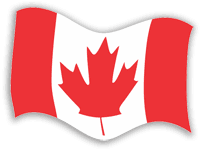|
As the second largest country in the world, larger than all of
Europe, Canada’s geographical statistics are truly impressive.
Canadian territory is immense, spanning six time zones,
stretching 5,500 km from west to east and 4,600 km from north to
south and encompassing over 9,000,000 square kms of land, and a
further million square kms of surrounding waters. At 244,000 km,
its coastline is the longest of any nation, touching three
oceans. The
landscape consists of seemingly endless mountains, prairie,
forest and Arctic tundra. A Canadian prime minister once
lamented that Canada had too much geography — over the years,
more than a few Canadians have agreed — but along with her
people, that geography remains Canada’s greatest resource.
Nowhere is that more obvious when considering the country’s
riches of fresh water. Two million lakes and giant glaciers hold
seven percent of the world’s total fresh water resource. But
this apparent abundance is misleading. Nearly two-thirds of this
fresh water drains into the Arctic Ocean, far from population
centres or areas of economic development. Water shortages in
southern Canada, for both human and industrial uses, are growing
more critical by the year, and much fresh water is polluted.
Meanwhile, losses of environmentally critical wetlands continue.
Geography has also left the country rich in other resources. The
Pre-Cambrian Shield, among the oldest rocks on earth, is a
treasure trove of mineral wealth, from gold and silver to iron,
nickel, and uranium, while huge boreal and temperate forests
sustain another industry. Largely in the form of tar sands,
northern Alberta contains among the largest petroleum reserves
in the world, though their extraction is environmentally costly.
Canada’s hydro-electric potential is almost as vast.
Although agriculture is a major industry, only eight percent of
Canada’s land is suitable for farming or grazing. The
cereal-producing great plains of southern Alberta, Saskatchewan
and Manitoba are by far the largest farmed area, but the richest
farm land is found in British Columbia and southern Ontario and
has suffered from urban sprawl. A once abundant fishery on both
coasts has been imperiled by overuse and the impact of climate
change.
If geography has dictated economic development and settlement,
it has just as fundamentally shaped Canada’s history. The sheer
size of the country imposed enormous obstacles to exploration,
settlement and economic development, and shaped Canada’s
distinct regions every bit as much as economic, political, and
social forces did. It was control of the few river routes
linking east to west during the fur trade period of the 1700s
and 1800s that in large measure accounted for Canada remaining
British rather than becoming American.
Climate and geography have been partners. The Canadian climate
varies from temperate in the south to Arctic in the far north.
But for newcomers, Canada all too often seems to be “10 months
of winter and two months of hard sledding,” and indeed, every
part of the country, except the West Coast, endures severe cold
for at least several months of the year. Surviving winter with a
minimum of complaint is a badge of honour, and snow-shoveling is
a skill mastered by all. Ottawa holds the unhappy distinction of
being one of the coldest capital cities in the world. No one
revels in the spring thaw, or a warm summer day, like a
Canadian. Not surprisingly, there has never been any illusion in
Canada that the climate can be mastered. Canadians battle the
harsh winter elements as they battle an unforgiving geography
but for us to endure is to triumph. Not surprisingly, that
capacity for endurance, that patience in the face of adversity,
is central to the Canadian character.
In the Canadian heart, The North is as much a concept as a
place. Fully 72 percent of Canadians live within 150 km of the
United States, 80 percent in cities. At the dawn of the 21st
century, most of Canada is hardly removed from wilderness. Even
residents of the largest cities can quickly go canoeing, hiking,
camping or fishing in solitude. But in truth, the great majority
of Canadians have been no closer to the country’s vast north
than the window of an airliner jetting to Europe. Nevertheless,
it is The North — the “great lone land” of Canadian writers and
painters — that defines Canada and its people. Even the words of
the national anthem — “the true north, strong and free” — serve
to remind Canadians that they live in a country defined by its
northern character.
Our northern geography also defines Canada’s greatest challenge:
the impact of relentless global warming on a fragile environment
as glaciers and permafrost melt and sea ice disappears. And when
in a few decades the Arctic becomes a navigable ocean, the very
claims of Canada to the vast island archipelago and interior
waters of the high Arctic will likely be challenged.
Next Instalment: The Governor General
The Canadian Experience
is a 52-week history series designed to tell the story of our
country to all Canadians. Sponsored by Multimedia Nova
Corporation and Diversity Media Services/Lingua Ads partners,
the series features articles by our country’s foremost
historians on a wide range of topics. Past articles and author
bios are available at http://www.cdnexperience.ca.
The Canadian Experience
is copyright © 2010-2011 Multimedia Nova Corporation.
|
List of
published "Canadian Experience" articles |


